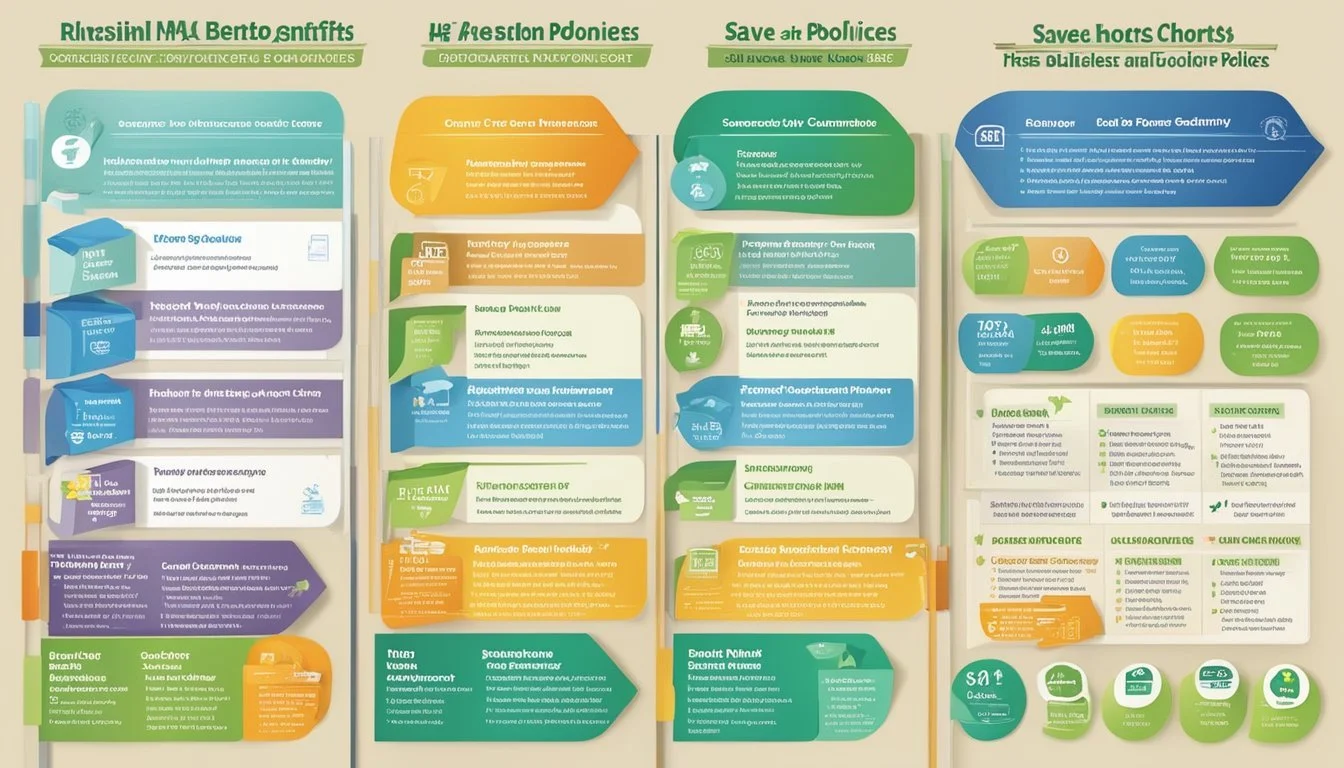H-E-B vs Save Mart
A Comprehensive Comparison of Price, Quality, and Selection
Grocery shopping is an essential part of everyday life, and choosing the right store can make a significant difference in your budget and overall experience. H-E-B and Save Mart are two popular grocery chains that cater to different regions of the United States. H-E-B primarily serves Texas, while Save Mart operates in California and Nevada.
When comparing H-E-B and Save Mart, H-E-B generally offers lower prices and a wider selection of products, particularly in its private-label offerings. H-E-B is known for its strong focus on Texas-sourced products and regional specialties, which appeals to many Texan shoppers. The chain has built a loyal customer base through its community involvement and tailored product offerings.
Save Mart, on the other hand, emphasizes fresh produce and local sourcing in its California and Nevada locations. While it may not match H-E-B's pricing on all items, Save Mart competes by offering quality produce and meat departments. Both stores strive to provide a pleasant shopping experience, but H-E-B's larger stores and broader range of services often give it an edge in customer satisfaction.
Brand Overview and Presence
H-E-B and Save Mart are two prominent grocery retailers with distinct histories and regional footprints. Their growth trajectories and market presence have shaped their current positions in the competitive grocery landscape.
History and Expansion of H-E-B
H-E-B began as a small family store in Kerrville, Texas in 1905. Founded by Florence Butt, the company expanded under her son Howard E. Butt, whose initials form the store's name.
H-E-B grew steadily throughout Texas, focusing on quality products and customer service. The company introduced innovative store formats like Central Market in 1994, catering to gourmet and specialty food shoppers.
Today, H-E-B operates over 400 stores across Texas and Mexico. Its stronghold remains in Texas, where it dominates major markets like San Antonio, Austin, and Houston. The retailer is known for tailoring stores to local communities and supporting regional products.
Save Mart's Growth and Market
Save Mart Supermarkets started in 1952 with a single store in Modesto, California. Founded by Nick Tocco and Mike Piccinini, the company focused on providing fresh produce and quality meats at competitive prices.
Over the decades, Save Mart expanded through organic growth and acquisitions. Notable purchases include Albertsons stores in 2006 and Lucky Stores in 2007, significantly increasing its presence in Northern California and Nevada.
The company now operates over 200 stores under various banners including Save Mart, Lucky, and FoodMaxx. Save Mart's market strength lies in California's Central Valley and the San Francisco Bay Area.
Store Footprint Comparison
H-E-B's store count exceeds 400, concentrated primarily in Texas. The retailer has a dominant presence in major Texan cities and surrounding areas. H-E-B stores vary in size, from smaller neighborhood markets to large-format stores exceeding 100,000 square feet.
Save Mart operates around 200 stores, mainly in California and Nevada. Its footprint is densest in Northern and Central California. Store sizes range from standard supermarkets to larger formats under the Lucky California banner.
Both retailers maintain strong regional identities. H-E-B is deeply ingrained in Texas culture, while Save Mart is a familiar name in Northern California communities. Neither has expanded significantly beyond their core regions, focusing instead on strengthening their existing markets.
Product Range and Quality
H-E-B and Save Mart offer diverse product selections to meet various customer needs. Both stores prioritize quality and freshness, but differences exist in their offerings and store brand options.
Variety of Products
H-E-B provides a wide array of products, including local and international items. Their stores typically stock around 18,000 products, covering essentials and specialty goods. Save Mart offers a more modest selection, focusing on staple items and regional favorites.
H-E-B excels in unique offerings like their Meal Simple prepared foods and extensive bakery sections. Save Mart concentrates on providing a solid range of everyday groceries and household items.
Both chains carry popular national brands alongside their store brands. H-E-B's larger stores may have more variety in categories like snacks, condiments, and international foods.
Organic and Non-Organic Selection
H-E-B has made significant strides in expanding its organic options. Their stores feature dedicated organic produce sections and carry a range of organic packaged goods.
Save Mart offers organic choices but typically has a smaller selection compared to H-E-B. Both stores stock organic fruits, vegetables, dairy, and pantry staples.
H-E-B's organic line includes items like:
Fresh produce
Dairy and eggs
Meats and poultry
Snacks and cereals
Save Mart's organic offerings tend to focus on produce and common grocery items. Both chains aim to provide affordable organic options to meet growing consumer demand.
Quality of Store Brands
H-E-B's store brands are highly regarded for their quality and value. Their main private label lines include:
H-E-B Brand: Everyday essentials
Hill Country Fare: Budget-friendly options
Central Market: Premium products
Save Mart's store brands, while less extensive, offer reliable quality at competitive prices. Their main private label is "Save Mart" for various grocery items.
H-E-B invests heavily in product development, often matching or exceeding national brand quality. Save Mart's store brands focus on providing good value for staple items.
Both chains conduct rigorous quality control for their private label products. H-E-B's broader range of store brands covers more specialty and gourmet items.
Diversity in Fresh Produce
Fresh produce is a key focus for both H-E-B and Save Mart. H-E-B is known for its extensive produce departments featuring local and seasonal items. They often highlight Texas-grown fruits and vegetables.
Save Mart emphasizes fresh, locally-sourced produce when possible. Their produce sections typically offer a solid selection of common fruits and vegetables.
H-E-B's produce departments may include:
Exotic fruits and vegetables
Pre-cut and prepared produce options
Organic and conventional choices
Save Mart focuses on stocking high-quality staple produce items. Both chains prioritize freshness and work with local farmers when feasible.
H-E-B often has a wider variety of specialty produce items. Save Mart concentrates on providing fresh, affordable options for everyday cooking needs.
Pricing and Value
Price is a key factor for many shoppers when choosing between grocery stores. H-E-B and Save Mart both aim to offer competitive pricing, but their strategies differ in important ways.
Everyday Prices and Deals
H-E-B is known for its consistent low prices on staple items. The Texas-based chain frequently offers deals on fresh produce, meat, and dairy products. Their "Meal Deals" provide discounts when purchasing ingredients for specific recipes.
Save Mart, on the other hand, tends to have slightly higher everyday prices. However, they make up for this with frequent sales and promotions. Their weekly circular often features deep discounts on select items, allowing savvy shoppers to stock up at low prices.
Both stores offer competitive prices on store-brand products. H-E-B's private label items are particularly well-regarded for their quality and value.
Comparison of Bulk Purchasing Options
H-E-B excels in bulk purchasing options. Many of their stores feature a bulk foods section where customers can buy grains, nuts, and dried fruits by weight. This allows for cost savings and reduces packaging waste.
Save Mart's bulk options are more limited. They do offer some items in larger quantities, particularly in their meat department. However, their focus is less on true bulk purchasing and more on family-sized packaging.
For staples like rice, flour, and sugar, H-E-B typically offers better bulk pricing. Save Mart compensates with occasional bulk purchase promotions, especially during holiday seasons.
Discounts and Savings Programs
Both H-E-B and Save Mart have loyalty programs that offer additional savings. H-E-B's program, called H-E-B Points, allows customers to earn points on purchases which can be redeemed for discounts on future shopping trips.
Save Mart's Save Smart Rewards program provides digital coupons and personalized deals based on shopping history. They also offer a fuel rewards program, allowing customers to save on gasoline purchases at participating stations.
H-E-B's digital coupons are integrated into their app, making them easy to access and apply at checkout. Save Mart's digital coupon system is similarly user-friendly.
Cost Analysis: H-E-B vs Save Mart
When comparing specific items, prices can vary:
Ground beef: H-E-B often has lower prices, especially on their store brand.
Bananas: Prices are typically similar, with both stores offering competitive rates.
Milk: H-E-B generally has a slight edge, particularly on gallon sizes.
Butter: Save Mart occasionally offers better deals through promotions.
For a typical grocery basket, H-E-B tends to come out slightly ahead in terms of overall cost. However, Save Mart's frequent sales can sometimes tip the balance in their favor for certain shopping trips.
Budget-conscious shoppers can find good deals at both stores by planning around sales cycles and using loyalty programs. H-E-B's everyday low prices make it easier to save consistently, while Save Mart rewards those who closely follow their promotions.
Customer Services and Shopping Experience
H-E-B and Save Mart offer distinct customer services and shopping experiences. Both chains strive to meet shopper needs through various amenities, online options, and support services.
In-Store Amenities and Layout
H-E-B stores typically feature spacious layouts with wide aisles and clear signage. Many locations include in-store dining areas, pharmacies, and floral departments. H-E-B often provides free samples and cooking demonstrations to enhance the shopping experience.
Save Mart stores are generally smaller but well-organized. They offer deli counters, bakeries, and produce sections. Some Save Mart locations have sushi bars and hot food stations.
Both chains prioritize cleanliness and maintain tidy, well-stocked shelves. H-E-B tends to have a more extensive selection of private-label products compared to Save Mart.
Online Shopping and Delivery Services
H-E-B offers a robust online shopping platform with home delivery and curbside pickup options. Their mobile app allows customers to create shopping lists, browse weekly ads, and place orders.
Save Mart provides online ordering through Instacart in select areas. Their website features digital coupons and weekly specials. However, their e-commerce capabilities are less developed than H-E-B's.
Both stores have expanded their delivery services in recent years, but H-E-B's in-house system is often praised for its reliability and user-friendly interface.
Customer Service and Support
H-E-B is known for its friendly and knowledgeable staff. They offer dedicated customer service desks in most stores and provide assistance with product inquiries, returns, and special orders.
Save Mart emphasizes customer service training for employees. They aim to create a welcoming atmosphere and offer help with locating items or addressing concerns.
Both chains have implemented measures to reduce wait times at checkout. H-E-B often has more lanes open during peak hours, while Save Mart utilizes self-checkout options in many stores.
Additional Benefits and Services
H-E-B offers a range of additional services, including:
Fuel stations at select locations
Community involvement programs
Cooking classes and nutrition education
Save Mart provides:
Money transfer services
Coinstar machines
Local product showcases
Both chains have loyalty programs that offer personalized discounts and rewards. H-E-B's program is generally more comprehensive, with targeted offers based on shopping habits.
H-E-B and Save Mart strive to cater to diverse customer needs. H-E-B tends to offer a wider array of services and a more immersive shopping experience, while Save Mart focuses on convenience and community connection in their smaller-format stores.
Company Policies and Customer Benefits
H-E-B and Save Mart offer various programs and policies to enhance the shopping experience. These include loyalty rewards, sustainability initiatives, customer-friendly return policies, and modern payment options.
Loyalty Programs and Rewards
H-E-B's Points Club Rewards allows customers to earn points on purchases. Members receive personalized coupons and exclusive discounts. Save Mart operates the Save Smart Rewards program. Shoppers accumulate points for fuel savings and grocery discounts.
Both stores offer digital coupons through their mobile apps. H-E-B's app features weekly ads and personalized deals. Save Mart provides a digital circular with special offers.
H-E-B sends a newsletter with additional savings opportunities. Save Mart emails subscribers about upcoming promotions and clearance items.
Sustainability and Ethical Shopping
H-E-B emphasizes sustainability through various initiatives. The company focuses on reducing waste, conserving energy, and supporting local farmers. Their stores feature recycling stations for plastic bags and electronics.
Save Mart promotes sustainability by offering reusable bags and encouraging recycling. The chain partners with local food banks to reduce food waste.
Both retailers stock a range of eco-friendly and organic products. H-E-B's private label includes several sustainable options. Save Mart carries fair trade items and locally-sourced produce when available.
Return Policies and Customer Guarantees
H-E-B offers a satisfaction guarantee on all products. Customers can return items with a receipt for a full refund or exchange. Without a receipt, store credit is provided at the current selling price.
Save Mart allows returns within 30 days of purchase with a receipt. Perishable items have a shorter return window. The store offers refunds, exchanges, or store credit depending on the situation.
Both chains have flexible policies for damaged or defective products. H-E-B and Save Mart train staff to handle returns efficiently and courteously.
Innovative Payment Options
H-E-B and Save Mart accept various payment methods. These include cash, credit/debit cards, and mobile wallets like Apple Pay and Google Pay.
H-E-B supports PayPal and Venmo for online orders. The chain offers Affirm financing for larger purchases. Save Mart provides Viabill financing support for eligible transactions.
Both stores accept EBT cards for SNAP benefits. H-E-B participates in the WIC program in Texas. Save Mart honors WIC vouchers in applicable states.
H-E-B and Save Mart offer gift cards and e-gift cards. These can be purchased in-store or online, providing flexible gifting options for customers.
External Factors and Brand Reputation
H-E-B and Save Mart's reputations are shaped by factors beyond their store walls. Customer feedback, online presence, and industry relationships play crucial roles in how these grocers are perceived.
Customer Reviews and Expert Opinions
H-E-B consistently receives high marks from customers and industry experts. The Texas-based chain topped dunnhumby's Retailer Preference Index, outranking major players like Amazon and Costco. Customers praise H-E-B's product quality, competitive pricing, and friendly service.
Save Mart, while less nationally recognized, maintains a solid reputation in its operating regions. Customer reviews highlight the chain's fresh produce and local product selections. However, Save Mart lacks the widespread acclaim that H-E-B enjoys.
Expert opinions often favor H-E-B. Industry analysts commend its innovative approach to grocery retail and ability to compete with larger national chains.
Social Media Influence and Online Presence
H-E-B boasts a strong social media following across platforms. The grocer's engaging content and responsive customer service enhance its online reputation. H-E-B's digital initiatives, including its mobile app and e-commerce platform, have garnered positive attention.
Save Mart's online presence is more modest. The company maintains active social media accounts but has a smaller follower base compared to H-E-B. Save Mart's digital offerings, while functional, don't generate the same buzz as H-E-B's tech-forward approach.
Both chains use social media for promotions and customer engagement, but H-E-B's strategies appear more advanced and wide-reaching.
Partnerships and Industry Standing
H-E-B has forged notable partnerships that bolster its industry standing. The grocer collaborates with local suppliers and has launched successful private label brands. H-E-B's community involvement and disaster relief efforts have earned it goodwill and respect.
Save Mart maintains strong regional partnerships, particularly with California-based producers. The company's focus on local sourcing enhances its reputation in its operating areas.
In terms of industry standing, H-E-B is recognized as an innovator and formidable competitor to national chains like Walmart and Kroger. Save Mart, while respected in its markets, doesn't command the same level of industry-wide influence as H-E-B.
Final Thoughts
H-E-B and Save Mart both offer unique shopping experiences for grocery customers. H-E-B has built a strong reputation in Texas for its wide selection of high-quality products and competitive prices. The chain is known for its clean stores and fresh produce offerings.
Save Mart, while less prominent nationally, provides a solid grocery shopping option in its operating regions. The company focuses on serving local communities and offering regional products.
Price-conscious shoppers may find better deals at H-E-B, as the chain is often competitive with larger national retailers like Walmart. Save Mart's prices can vary by location and may not always match the lowest in the market.
Product selection differs between the two chains. H-E-B typically carries a broader range of items, including many of its own private label brands. Save Mart's inventory may be more limited but often includes locally sourced options.
Customer service is a priority for both retailers. H-E-B has cultivated a loyal following in Texas, while Save Mart aims to maintain strong community connections in its markets.
Ultimately, the choice between H-E-B and Save Mart will depend on individual preferences, location, and specific shopping needs. Both chains strive to meet customer demands in their respective markets.







